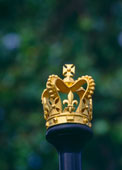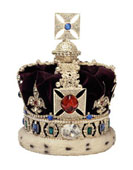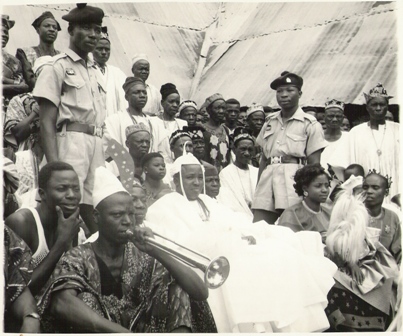
History of Emure-Ekiti
Introduction:
Emure-Ekiti, a Yoruba town in the Western part of Nigeria, is the headquarters of Emure Local Government in Ekiti State. Elemure (the monarch of Emure-Ekiti) is one of the Sixteen Beaded Crown Obas (Kings) in Ekiti Land. The population of Emure-Ekiti as at the 2006 National Census is 94,264.The ancestors of the present Emure Ijaloke, which is also known as Emure-Ekiti can be traced back to Ile-Ife, the cradle of the Yoruba race. Emures relate through oral report that Fagbamila Obadudu, the progenitor of Emure was one of the sons of Obele. Obele was the son of Oranmiyan who happened to be the last son of Okanbi, the only son of Oduduwa, the acclaimed father of the Yoruba race. |
Oduduwa
Okanbi
Oranmiyan
Obele
Obadudu
(Progenitor of EMURE-EKITI)
It was common in those days for kings to instruct their sons to go out and search for places to build their own kingdoms. In that tradition, Prince Fagbamila Obadudu was bidden by his father to look for a territory where he could settle with his own people. He was sent forth with blessings by the entire Oduduwa royal family as he left Ile-Ife. In addition, Prince Obadudu was given the following paraphernalia of royalty – a Beaded Crown, a Sword (to win laurels in battle), Fern Leaves, Akoko Leaves, Atorin (cane), and a Giant Leather Fan made of Tiger Skin. The Fern Leaf is called Imu in Yoruba language and the name of the town was derived from the act of giving the Fern Leaves to Obadudu – Imu re re e o, meaning these are your Fern Leaves.
Obadudu left Ile-Ife with many followers, intent on carving a kingdom for himself. He had many temporary stopovers in diverse abodes, before he finally settled at a place called IGBO-OWA near River Ose. The kingdom flourished - a large settlement sprang up, giving birth to a powerful kingdom. Emures remained at Igbo-Owa for some centuries, nevertheless, as the popular saying goes, whatever has a beginning must surely have an end – Emure people had to migrate, searching for another place to settle in. There are two conflicting accounts of what led to the disintegration of the great Igbo-Owa kingdom. One account says the demise came about as a result of its enlargement, which led to internal crises while another account sees it as resulting from external attacks by neighboring kingdoms. Attacks from Oba Ado, Bini (Benin Kingdom) drove them from the settlement and led to the fragmentation of the Igbo-Owa kingdom. Components of this great kingdom which later fragmented included Awo, Odo-Emure (now known as Odo-Emure Agbado). Other people settled in Ado-Ani (now called Idoani), Oba (now known as Oba Akoko), Ipeme, and a host of other towns. As the Emures departed from Igbo-Owa in their search for an Eldorado, they got to a habitable place, and the elderly ones felt it was commodious enough for them to settle there, since they were not strong enough to participate in a long trek, and promptly named it Emure-Ile, meaning they had ‘arrived home’. After settling the elderly people at Emure-Ile, the younger ones proceeded to a place called Emure Ijaloke, which is now known as Emure-Ekiti.
Ijaloke was formerly named Oke-Oko, a farm settlement for Igbo-Owa residents and it received the name ‘Ijaloke’ because a big fight broke out among the people farming at the settlement, and this was reported at Igbo-Owa as – ‘Ogun ja l’Oke Oko’ (there was a war at Oke-Oko). This was later grafted onto the settlement’s name, which then became known as Ijaloke. It was in 1780 that Emures relocated to Emure Ijaloke from Igbo-Owa. They were led to the new site by Adumori Ogunragaboja, who became the first ruler of Emure Kingdom.
The Ibadan Wars (1874 – 1875) and the Kiriji War (Ekitiparapo vs Ibadan)
The late nineteenth century in the life of Emures was marked by experiences of war. In 1874, Ogedengbe, the Ijesa Warlord laid siege against Ise, which was then a tributary town to Ibadan. Ise then appealed to Ibadan for help, and Ibadan sent a formidable army to rescue Ise. When Ogedengbe learnt about Ibadan’s advance, he raised the siege and retreated to his stronghold at Ita-Ogbolu in the Akure District. When the Ibadans arrived in Ise and discovered that Ogedengbe was no more there, they decided not to return home empty-handed and therefore turned their attention to Emure. A short skirmish ensued, with the Ibadan people gaining the upper hand. The Emure warriors retreated, and many of the citizens were taken away to Ibadan. Elemure Oba Ogunsusi Ajirotutu Aroloye later brought his people (Emures) back from Ibadan.
It was erroneously alleged in some circles that Emures did not send troops to the Ekitiparapo camp at Kiriji when the alliance was formed to ward off the attack of the Ibadans during the Ekitiparapo vs Ibadan war (1878 - 1893). This allegation was strongly denied by Emures because some of the Emure warriors who escaped when Ibadan attacked Emure in 1874 and those that King Ogunsusi Ajirotutu brought back from Ibadan regrouped and joined the Ekitiparapo alliance to prosecute the Kiriji war.
Emure under British Rule
In 1893, the protectorate of Yorubaland was established and signed in Ibadan. In the same year, a patrol under Captain R. E. D. Campbell, Lagos Constabulary visited Ekiti. Captain R. L. Bower was appointed Resident and Travelling Commissioner of Interior Yorubaland. In 1899, the North-East District was formed and a Commissioner was appointed to Ijesa and Ekiti with his seat at Oke Imo in Ilesa. The Ekiti Division was formed into a separate Division on January 1, 1913 and became part of the Ijebu-Ode Province. On July 1, 1915, the Ekiti Division was transferred to the newly-formed Ondo Province with its headquarters at Akure. Ekiti towns were later grouped into Districts under the control of an Oba (King) and Emure got her own district under the Elemure in 1929 after Elemure Oba Joseph Ogunloye Arosoye (Ajirotutu IV) had been able to secure a copy of the Lost Gazette showing that Emure was an Ekiti Kingdom. Oba Ogunloye Arosoye (Ajirotutu IV) was the first literate person to become the Elemure. This made his rule to be very beneficial to the Emure people in diverse ways.
Monetary System in Emure
Emures have been very versatile and industrious down through the ages. In earliest times, like in other parts of Africa, exchange was by Trade-by-Barter among the less privileged, while cowries were used by the rich people in society. The Copper coin as a means of exchange was introduced in 1917, which the people called Ayelujara – (describing the round hole in the coin). The use of copper as legal tender made trading more convenient. As opposed to cowries, it was light and easier to transport over long distances. By 1919, currency notes also came into circulation.
Emure-Ekiti in the Comity of Towns
Oba Emmanuel Taiwo Ogunleye II, Elemure of Emure (1965-1974) was the Chairman, Ekiti Southern District Council of Obas, which comprised of the present Four Local Government Areas: Ikere Local Government, Ekiti South-West Local Government, Ise-Orun Local Government and Emure Local Government. These Local Government Areas comprise of the following towns: Ikere, Ogotun, Ise, Igbara-Odo, Ilawe, Emure, Orun, Eporo and all the villages under the afore-mentioned towns. He held the chairmanship until he joined his ancestors on the 25th of November, 1974. This also added a special value onto the image of Emure-Ekiti, making it a primus inter pares (first among equals). Elemure Oba Emmanuel Taiwo Ogunleye II Amugbayanwo provided sound leadership to the people, being a scholar, educationist and charismatic leader.
Geographical Overview
Emure-Ekiti is located 70 27’ 00” North and 50 28’ 0” East. It is bounded in the North by Agbado-Ekiti in Gbonyin Local Government, in the South by Owo in Ondo State, in the West by Orun-Ekiti in Ise/Orun Local Government and in the East by Supare in Ondo State. Emure-Ekiti is situated 43 Kilometres from Ado-Ekiti, the Capital of Ekiti State, 61 Kilometres from Akure, the Capital of Ondo State, 373 Kilometres from Lagos, the commercial nerve-centre of Nigeria and 684 Kilometres from Abuja, the Nigerian Federal Capital.
Climate
Just like in every part of the world, there are varieties of seasons in Emure-Ekiti. The seasons include the Rainy Season (April – October) and the Dry Season, which is also the harbinger of the Harmattan (November - March). During the rainy season, the rainfalls can be graded according to intensity – there are light showers, scattered rainfalls and heavy deluge.
Topography
Emure-Ekiti is a delectable combination of rivers, brooks, hills and lowlands. The hills include Oguru and Ose. The brooks include Aro, P’Ologomusi-P’Obitun, Orisa, Onioran, Olojido and Orisirun. The popular River Ose also passes through Emure-Land.
Traditional Administration
In most parts of Africa, the basis of organization is the family. In Yoruba language, the family is known as Ebi. The family system affects every aspect of life. As far back as the primordial times, Chiefs were appointed by family interests and affiliations and land was regarded as family land. The main forum for the Ebi is the Family Council, which is presided over by the person regarded as the head of the family. Family meetings (Omo-Ebi meetings) are held on a regular basis. At these meetings, family matters are discussed, e.g., division of family land, arrangements for performing family ceremonies and the filling of family titles which have become vacant.
The traditional administration is built up in form of a hierarchy. At the zenith of the administration is the Oba (King), the de facto ruler of the domain. In traditional phraseology, Oba is described as Alase Ekeji Orisa ‘God’s Second-in-Command’. Absolute power rests in the hand of the king. However, to serve in an advisory capacity is a council of chiefs known as Elumo, which is the highest council in the land. It also performs the function of the Judiciary. Its judgment is final and can neither be reviewed nor appealed. The Elemure himself presides over the Council. The Legislative arm of the government is provided by another Council of Chiefs known as Iwarafa Mefa. The Chiefs in this council are responsible for law-making. The council is also presided over by the Oba.
The Military formed an important facet of traditional administration in Emure-Ekiti and it was made up of War Chiefs called Elegbe or Ologun. Their uniforms and caps were designed in a way to instill fear and awe in the minds of their opponents.
Abore: On the spiritual front were the Abore – Traditional priests. Their duties included propitiating the gods and providing spiritual cover for the people of the kingdom.
Abioro: There is a hierarchy in the execution of various works that need to be carried out within the community. At the peak are the Abioro. They relate directly with the Oba, who instructs them on duties of any type that need to be performed within the kingdom. The Abioro in turn relate with the Igbamo who would physically perform the duties. At the head of the Igbamo is the Olotu.
Quarters:
Emure is divided into four main quarters viz:
1. Oke-Emure
2. Odo-Emure
3. Ogbontioro
4. Idamudu
The Palace:
The palace is centrally located within the city, and it is the seat of administration/power. It is located at a point where all the four quarters meet, thereby forming a sort of link for all the quarters.
Rulers:
The Elemure’s Crown, as earlier stated, was brought from Ile-Ife when Emure’s founder, Prince Obadudu left to carve out his own kingdom. Elemure started his kingdom as a bona-fide wearer of a beaded crown. Emure is one of the sixteen traditional Ekiti Kingdoms.
Since 1780 when Emure people came from Igbo Owa Kingdom to the present site called Emure Ijaloke, now known as Emure-Ekiti, eight Obas (Kings) had ruled in the kingdom before HRM Elemure Oba Alayeluwa Emmanuel Taiwo Ogunleye II Amugbayanwo was enthroned in 1965. He thus became the ninth (9th) Elemure, ruling from 1965 to 1974. All of them came from the Adumori Ruling House.
The first ruler (Elemure) was Adumori Ogunragaboja who led the Emure people from Igbo Owa to the present site. He was a direct descendant of Obadudu. The royal line, Adumori Ruling House was named after him. The Elemure’s profiles are as follow:

The nine Obas (Kings) mentioned above originated from the Adumori Ruling House. The present ruler is HRM Elemure Oba Emmanuel Adebowale Adebayo, Atayero bi Agogo Aminmin III, and he is also from the Adumori Ruling House. He is the grandson of Elemure Oba Peter Adebayo Ajimudaoro Aminmin II.
Towns & Villages within Emure Kingdom
Within the geographical space known as Emure kingdom, there are over sixty towns and villages. These include:
1. Aba Adewale 2. Aba Adeyemo 3. Aba Ajiboye 4. Aba Ajireni 5. Aba lade 6. Aba Amin 7. Ba Egin 8. Ba Ojilo 9. Adeboye
10. Agbanimu 11. Ago Sasere 12. Ajebandele 13. Akeye 14. Alabamarun 15. Alapoto 16. Amuroko 17. Anaye 18. Ayelala
19. Eporo Ekiti 20. Ibeji Adu (Aro II) 21. Ibeji Adu (Aro I) 22. Ibeji Owode 23. Oniyawa 24. Ibeji Ajegunle 25. Ibeji Shittu
26. Ibeji Shittu II 27. Idi Ope 28. Igbo Eku 29. Igbo Rowa 30. Igbo Owa 31. Ilu Oge 32. Oko Itaragba 33. Oke Sett 34. Oke Seri
35. Oko Ose Kolade 36. Oko Ose Onija 37. Omaje 38. Opticum 39. Ose 40. Owode 41. Owosi 42. Owosi Oba 43. Oyimo
44. Sasere etc.
Festivals
Traditional festivals provide a glimpse into the life of African societies. They serve as syntheses of various art forms and also reflect the religious sensibilities of the people. Emure-Ekiti is no exception in this regard. There are many festivals in the Emure calendar:
1. Egungun: This festival is regarded as an ‘all-saints’ affair, when the ancestors ‘return’ as masked beings to visit their children. The egungun festival is celebrated in the month of April. The masquerades go to the palace to pay homage to the King. The festival enjoys participation from the four quarters of the town - Oke-Emure, Odo-Emure, Ogbontioro and Idamudu.
2. Opa Oguru – Festival performances are sometimes used as corrective measures in society and Opa Oguru festival fits perfectly into this function. During the festival, through music and dance, people who had perpetrated one form of misdeed or the other are castigated and held up to ridicule or moral opprobrium. This serves as a deterrent to potential misconduct.
3. Airegbe: This is an age-grade dance group, which marks a sort of ‘rite-of-passage’ from maidenhood to womanhood. It is marked by dancing, singing, fashion parade, etc.
4. Ile-Odun: It is an all-male festival, comprising of only indigenes of Emure-Ekiti. It is mandatory for all male indigenes as from the age of four.
5. Ogun: This is celebrated in honor of Ogun, the god of iron.
6. Ajale: Festival in honor of Ajale, god of war.
7. Etintin: Female celebration. Participants are garbed in white wrappers, while bearing pots of water and pealed whips from Aro brook.
8. Iluyanwa: New Yam Festival celebrated by the King every September.
9. Ero: Rite of passage for men to mark passage from ‘Gbamo’ age group to adulthood. This festival is observed every nine years.
Agricultural and Mineral Resources
The main occupation of the people of Emure-Ekiti is Agriculture. Emure men are predominantly farmers, while their women engage in trading. The mode of agriculture initially practiced was predominantly traditional – utilizing basic equipment such as cutlasses and hoes. In modern times, the conservative method is gradually giving way to mechanized farming.
The main cash crops grown in Emure kingdom are Cocoa, Kola-nut, Palm-Tree, Tobacco, Cashew, etc. The major food crops grown in this area include Yam, Cassava, Cocoyam, Maize, Plantain, Banana, different species of Beans, varieties of Vegetables, Peppers, Tomatoes, etc. Tree crops include Coconut, Mango, Citrus Fruits, Guava, etc.
Mineral Resources found in Emure-Ekiti include Charconite Granite, Clay Kaolin, etc.
Emure’s Christian Heritage
Very early in the life of Emure Kingdom, Christianity was introduced. Many churches sprang up, and they were later followed by the establishment of mission schools and health facilities. The first Anglican educational institution – St. Paul’s Anglican Primary School – was established in 1919, while the Catholic Church was established in 1920. The Sacred Heart Catholic Primary School was founded in 1925. Today, so many churches, such as the Christ Apostolic Church (founded in 1937), Baptist, Methodist, Apostolic Faith Mission (founded in 1974), Deeper Christian Life Ministry, Redeemed Christian Church of God and a host of others have spread their tentacles through the nooks and crannies of Emure-Ekiti.
Islam
Islam was a latecomer, compared with other religions. The first Muslim primary school, Ansarudeen Primary School, was established in 1949.
Education in Emure Kingdom
Emure-Ekiti people are so much in love with education. As a matter of fact, the kingdom belongs to a state in the federation which is described as the "Fountain of Knowledge", due to the vast number of educated people as well as the number of educational institutions in the state. This is not unconnected with the pronounced Christian missionary activities in the state which led to the establishment of many schools in Emure-Ekiti. |
|
|




